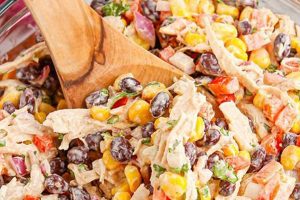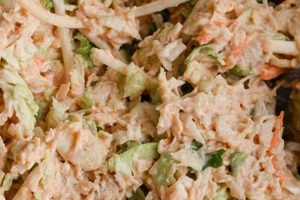This dish typically combines cooked chicken with mayonnaise, curry powder, and often includes additional ingredients like grapes, raisins, apples, celery, and almonds. Variations exist, incorporating chutney, yogurt, or different types of curry powder for unique flavor profiles. A popular version emphasizes using high-quality ingredients and simple preparation techniques for optimal flavor and texture.
This particular preparation has gained popularity due to its accessibility, balanced flavor profile, and adaptability. The blending of savory chicken, creamy mayonnaise, and the warm spice of curry creates a versatile dish suitable for sandwiches, salads, wraps, or enjoyed as a standalone appetizer. Its appeal lies in its make-ahead convenience and adaptability to various dietary preferences, with adjustments possible for vegan, gluten-free, or lower-fat versions.
Further exploration can delve into specific ingredient selections, step-by-step preparation methods, nutritional information, and suggested serving options. A deeper understanding of ingredient combinations and culinary techniques will empower readers to create and personalize their own versions of this classic dish.
Tips for a Delicious Curry Chicken Salad
Achieving a well-balanced and flavorful curry chicken salad involves attention to detail and careful selection of ingredients. The following tips offer guidance for optimal results.
Tip 1: High-Quality Chicken: Roasting a whole chicken or using leftover roasted chicken yields superior flavor compared to pre-cooked or poached chicken.
Tip 2: Freshly Ground Curry Powder: Pre-ground curry powder can lose its vibrancy. Freshly grinding whole spices enhances the aromatic complexity of the dish.
Tip 3: Balancing Sweet and Savory: Incorporating sweet elements like grapes, raisins, or chopped apple balances the savory notes of the chicken and curry. Adjust sweetness levels to personal preference.
Tip 4: Textural Variety: Adding chopped celery, toasted almonds, or water chestnuts introduces textural contrast and enhances the overall sensory experience.
Tip 5: Mayonnaise Selection: Good quality mayonnaise is crucial for flavor and creaminess. Experiment with different brands or consider making homemade mayonnaise for optimal control over ingredients.
Tip 6: Chill Time: Allowing the salad to chill for at least an hour before serving allows the flavors to meld and enhances the overall experience.
Tip 7: Customization: Flavor profiles can be customized with additions such as chutney, chopped fresh herbs (cilantro or mint), or a squeeze of lemon juice.
By following these tips, one can create a curry chicken salad that is both flavorful and satisfying. Attention to detail in ingredient selection and preparation ensures a delightful culinary experience.
These guidelines provide a foundation for achieving culinary excellence in preparing curry chicken salad. Exploration of variations and personal adjustments based on individual preferences is encouraged.
1. High-quality Chicken
High-quality chicken serves as the foundation of a flavorful and satisfying curry chicken salad, particularly within the context of Ina Garten’s approach. The quality of the chicken directly impacts the final dish’s overall taste and texture. Understanding the nuances of selecting and preparing chicken elevates this seemingly simple salad to a culinary experience.
- Flavor Enhancement
Chicken provides a neutral canvas for the other ingredients. High-quality chicken, such as free-range or organic varieties, possesses a richer, more pronounced flavor that complements, rather than gets masked by, the curry spices and other additions. The inherent flavor of the chicken enhances the complexity of the final dish. This distinction becomes particularly noticeable in a delicately balanced recipe like Ina Garten’s.
- Texture and Moisture
The cooking method and quality of the chicken significantly influence the final texture of the salad. Overcooked chicken results in a dry, stringy texture that detracts from the overall enjoyment. High-quality chicken, properly cooked, retains moisture and contributes to a more desirable, tender consistency in the salad.
- Freshness and Sourcing
Freshly roasted or rotisserie chicken, as often recommended in Garten’s recipes, generally yields a superior outcome compared to pre-cooked or processed chicken. Freshness ensures optimal flavor and texture. Sourcing practices, such as choosing free-range or organic options, also play a role in both flavor and ethical considerations.
- Overall Culinary Impact
Investing in high-quality chicken demonstrates a commitment to using premium ingredients, reflecting a broader culinary philosophy. While seemingly a minor detail, the choice of chicken significantly elevates the final dish. This aligns with Garten’s overall approach to cooking, which emphasizes quality ingredients as a key component of delicious, well-executed recipes.
By prioritizing high-quality chicken, one can create a curry chicken salad that truly shines. The nuanced flavor and desirable texture of the chicken provide a solid foundation for the other ingredients to build upon, ultimately leading to a more satisfying and enjoyable culinary experience reflective of Ina Garten’s culinary principles.
2. Balanced Curry Blend
A balanced curry blend is crucial to a successful curry chicken salad, especially within the context of Ina Garten’s recipes. The complexity and depth of flavor derived from a well-crafted blend elevate the dish beyond a simple combination of ingredients. This balance hinges on understanding the interplay of various spices and their individual contributions to the overall profile.
Garten’s approach often features Madras curry powder, known for its complex flavor profile incorporating elements of heat, sweetness, and earthiness. However, a balanced blend extends beyond a single type of curry powder. It often involves incorporating additional spices like turmeric, cumin, coriander, and ginger, each contributing unique characteristics. The proportions of these spices influence the final flavor, allowing for customization based on desired outcomes. For instance, increasing the proportion of cayenne pepper adds heat, while a higher concentration of coriander enhances the earthy notes. The interplay of these flavors creates a nuanced and well-rounded taste experience, characteristic of Garten’s culinary style.
The practical significance of this understanding lies in the ability to tailor the curry blend to individual preferences. While pre-made curry powders offer convenience, blending individual spices allows for greater control over the final flavor profile. Freshly ground spices further enhance the vibrancy and aromatic intensity of the blend. This control empowers one to create a curry chicken salad that precisely balances heat, sweetness, and earthiness, achieving a complexity often absent in recipes relying solely on pre-mixed curry powders. Ultimately, a balanced curry blend ensures the curry chicken salad offers a depth of flavor that complements the other ingredients, creating a cohesive and satisfying culinary experience.
3. Mayonnaise (homemade preferred)
Mayonnaise plays a critical role in curry chicken salad, acting as a binding agent and contributing significantly to the overall texture and flavor. Within the context of Ina Garten’s approach, the preference for homemade mayonnaise underscores a commitment to quality ingredients and maximizing flavor control. This seemingly minor detail significantly impacts the final dish’s overall quality.
- Flavor Enhancement and Control
Homemade mayonnaise allows for precise control over ingredients and flavor profiles. Adjustments to the type of oil, vinegar, and seasonings can significantly impact the final taste. This level of customization is crucial for balancing the complex flavors of curry spices and other additions in the salad. Garten’s emphasis on homemade mayonnaise allows for a harmonious blend of flavors where the mayonnaise complements, rather than masks, the other components.
- Texture and Emulsification
The texture of mayonnaise contributes directly to the mouthfeel of the curry chicken salad. Homemade mayonnaise, typically made with fresh eggs and oil, offers a richer, creamier texture compared to commercially produced versions. The controlled emulsification process in homemade mayonnaise ensures a stable and consistent texture throughout the salad.
- Freshness and Quality of Ingredients
Homemade mayonnaise utilizes fresh, high-quality ingredients, aligning with Garten’s overall culinary philosophy. Avoiding preservatives and additives common in commercial mayonnaise contributes to a cleaner flavor profile. The freshness of the ingredients also contributes to the overall brightness and vibrancy of the salad.
- Overall Culinary Impact
Opting for homemade mayonnaise elevates the curry chicken salad, reflecting an attention to detail often associated with high-quality cuisine. While store-bought mayonnaise offers convenience, the nuanced flavor and superior texture of homemade mayonnaise demonstrate a commitment to culinary excellence. This aligns with Garten’s focus on using the best possible ingredients to achieve optimal results.
The preference for homemade mayonnaise in a curry chicken salad, particularly within the context of Ina Garten’s recipes, ultimately contributes to a superior culinary experience. The enhanced flavor, texture, and overall quality achieved through homemade mayonnaise exemplify Garten’s approach to cooking, where seemingly small details contribute significantly to the final outcome. The added effort reflects a deeper understanding of the interplay of ingredients and their impact on the overall dish, ultimately resulting in a more nuanced and satisfying culinary creation.
4. Sweet and Savory Additions
The interplay of sweet and savory elements forms a defining characteristic of many curry chicken salad recipes, particularly those inspired by Ina Garten’s approach. This balance contributes significantly to the complexity and overall appeal of the dish. The strategic inclusion of sweet ingredients tempers the savory notes of the chicken and curry spices, creating a more nuanced and balanced flavor profile. This dynamic interplay prevents the dish from becoming overly savory or one-dimensional, enhancing its palatability.
Common sweet additions include grapes, raisins, chopped apples, or dried cranberries. These ingredients introduce a subtle sweetness that complements the richness of the mayonnaise and the warmth of the curry spices. The choice of specific sweet additions can be tailored to individual preferences and the overall desired flavor profile. For instance, the tartness of green grapes offers a refreshing contrast, while the sweetness of golden raisins provides a more mellow complement. This flexibility allows for customization and personalization within the broader framework of a curry chicken salad recipe.
The practical significance of this understanding lies in the ability to tailor the sweetness level to achieve a harmonious balance. Careful consideration of the type and quantity of sweet additions allows for control over the final flavor profile. Overly sweet additions can mask the other flavors, while insufficient sweetness may result in a dish that is overly savory. Achieving the right balance ensures that the sweetness complements, rather than dominates, the other components, creating a more sophisticated and enjoyable culinary experience. This nuanced approach to balancing flavors aligns with Garten’s overall culinary philosophy, which emphasizes the importance of using high-quality ingredients and thoughtful preparation techniques to create dishes that are both delicious and well-balanced.
5. Textural Contrasts
Textural contrast contributes significantly to the overall enjoyment of curry chicken salad, particularly within the context of Ina Garten’s recipes. A varied textural experience elevates the dish beyond a simple combination of flavors, engaging multiple senses and creating a more dynamic and satisfying culinary experience. Garten’s approach often incorporates ingredients that provide contrasting textures, preventing a monotonous mouthfeel.
Common textural elements include toasted nuts (almonds, cashews, or pecans), chopped celery, water chestnuts, or dried fruit. These ingredients offer contrasting levels of crispness, crunch, and chewiness against the backdrop of the tender chicken and creamy mayonnaise. The interplay of these textures creates a more engaging and enjoyable eating experience. For instance, the crunch of toasted almonds provides a sharp contrast to the soft chicken, while the subtle crispness of celery adds another layer of textural complexity. The strategic inclusion of these elements prevents the salad from becoming overly smooth or homogenous, ensuring a more stimulating and satisfying sensory experience.
The practical significance of understanding textural contrast lies in the ability to tailor the dish to individual preferences. Consideration of various textural elements allows for a personalized approach to creating curry chicken salad. One might prefer a predominantly crunchy salad with a higher proportion of nuts and celery, while another might opt for a softer texture with a greater emphasis on the creamy mayonnaise and tender chicken. This understanding empowers one to create a curry chicken salad that not only tastes delicious but also offers a delightful textural experience, reflecting a more nuanced and sophisticated approach to culinary creation, characteristic of Ina Garten’s culinary style.
Frequently Asked Questions
This section addresses common inquiries regarding curry chicken salad, particularly in relation to recipes inspired by Ina Garten.
Question 1: What type of curry powder is recommended?
While Madras curry powder is often favored for its balanced flavor profile, experimentation with other varieties, such as yellow curry or Vindaloo, is encouraged. Flavor preferences vary, and exploring different curry powders allows for customization.
Question 2: Can the recipe be made ahead of time?
The salad benefits from chilling, allowing flavors to meld. Preparing it a day in advance enhances the overall taste experience. Store airtight in the refrigerator.
Question 3: What are suitable serving suggestions?
Curry chicken salad offers versatility. It can be enjoyed in sandwiches, wraps, lettuce cups, or as a standalone salad. Crackers or crudits also provide complementary accompaniments.
Question 4: Can the mayonnaise be substituted?
While homemade mayonnaise is often preferred, Greek yogurt or a combination of mayonnaise and Greek yogurt offer lower-fat alternatives. Adjustments to seasonings might be necessary to maintain flavor balance.
Question 5: How can the heat level be adjusted?
The amount of cayenne pepper or other chili-based spices in the curry powder dictates the heat level. Reducing or omitting these spices reduces the spiciness. Incorporating a dash of cayenne pepper enhances the heat for those who prefer a spicier salad.
Question 6: What are ideal chicken cooking methods for this recipe?
Roasting or poaching bone-in, skin-on chicken breasts yields optimal flavor and moisture. Utilizing leftover roasted chicken offers a convenient alternative. Avoid overcooking, as this can result in dry chicken.
Careful attention to ingredient selection and preparation techniques contributes significantly to the overall success of the dish. Adapting recipes to individual preferences allows for a personalized and enjoyable culinary experience.
Further exploration of specific variations and serving suggestions can enhance appreciation for the versatility and adaptability of curry chicken salad.
Conclusion
Exploration of this culinary concept reveals the importance of quality ingredients, balanced flavors, and textural contrasts in achieving a successful outcome. Emphasis on freshly roasted chicken, a nuanced curry blend, homemade mayonnaise, and the strategic inclusion of sweet and savory elements distinguishes this dish. Attention to detail, from ingredient selection to preparation techniques, contributes significantly to the overall culinary experience.
The adaptability of this dish allows for personalized interpretations and variations based on individual preferences. Continued exploration of diverse curry powders, complementary ingredients, and innovative serving suggestions promises further culinary discoveries. Understanding the underlying principles of flavor balance and textural interplay empowers culinary enthusiasts to create personalized versions of this classic dish while appreciating the foundations established by established culinary figures like Ina Garten.






